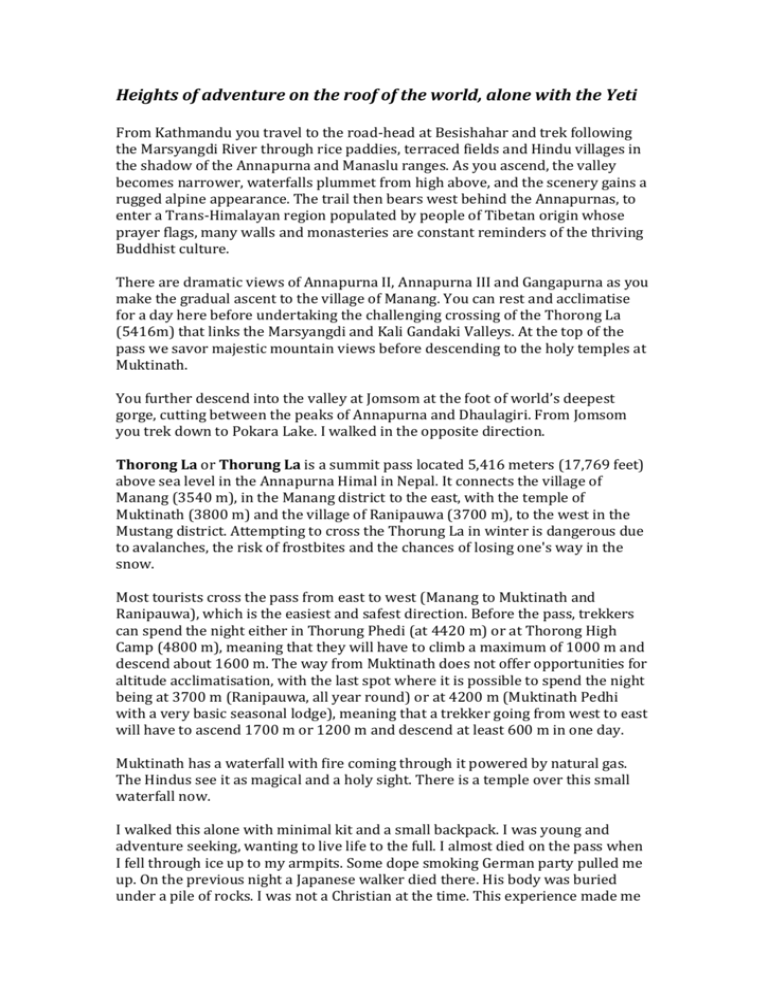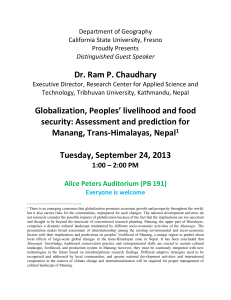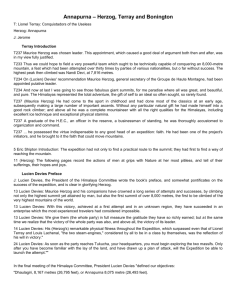Heights of adventure on the roof of the world
advertisement

Heights of adventure on the roof of the world, alone with the Yeti From Kathmandu you travel to the road-head at Besishahar and trek following the Marsyangdi River through rice paddies, terraced fields and Hindu villages in the shadow of the Annapurna and Manaslu ranges. As you ascend, the valley becomes narrower, waterfalls plummet from high above, and the scenery gains a rugged alpine appearance. The trail then bears west behind the Annapurnas, to enter a Trans-Himalayan region populated by people of Tibetan origin whose prayer flags, many walls and monasteries are constant reminders of the thriving Buddhist culture. There are dramatic views of Annapurna II, Annapurna III and Gangapurna as you make the gradual ascent to the village of Manang. You can rest and acclimatise for a day here before undertaking the challenging crossing of the Thorong La (5416m) that links the Marsyangdi and Kali Gandaki Valleys. At the top of the pass we savor majestic mountain views before descending to the holy temples at Muktinath. You further descend into the valley at Jomsom at the foot of world’s deepest gorge, cutting between the peaks of Annapurna and Dhaulagiri. From Jomsom you trek down to Pokara Lake. I walked in the opposite direction. Thorong La or Thorung La is a summit pass located 5,416 meters (17,769 feet) above sea level in the Annapurna Himal in Nepal. It connects the village of Manang (3540 m), in the Manang district to the east, with the temple of Muktinath (3800 m) and the village of Ranipauwa (3700 m), to the west in the Mustang district. Attempting to cross the Thorung La in winter is dangerous due to avalanches, the risk of frostbites and the chances of losing one's way in the snow. Most tourists cross the pass from east to west (Manang to Muktinath and Ranipauwa), which is the easiest and safest direction. Before the pass, trekkers can spend the night either in Thorung Phedi (at 4420 m) or at Thorong High Camp (4800 m), meaning that they will have to climb a maximum of 1000 m and descend about 1600 m. The way from Muktinath does not offer opportunities for altitude acclimatisation, with the last spot where it is possible to spend the night being at 3700 m (Ranipauwa, all year round) or at 4200 m (Muktinath Pedhi with a very basic seasonal lodge), meaning that a trekker going from west to east will have to ascend 1700 m or 1200 m and descend at least 600 m in one day. Muktinath has a waterfall with fire coming through it powered by natural gas. The Hindus see it as magical and a holy sight. There is a temple over this small waterfall now. I walked this alone with minimal kit and a small backpack. I was young and adventure seeking, wanting to live life to the full. I almost died on the pass when I fell through ice up to my armpits. Some dope smoking German party pulled me up. On the previous night a Japanese walker died there. His body was buried under a pile of rocks. I was not a Christian at the time. This experience made me think about life and death. What a fine line there is between the two. What happens when we die? Did God save me for a purpose? I knew that He had. My life would be different from here on. Tim Rogers About the author: Tim Rogers gave his life to the service of God in his youth. He went on to establish Christian schools and motivate the lives of many young people. If Tim were here today he would say, “No time to waste. Find out what God wants you to do, and do it with all your might.”








